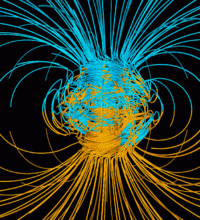
Photo from wikipedia
Unveiling the fundamental dynamics of naturally or artificially formed magnetic quasicrystals in the presence of an external magnetic field remains a difficult problem that may have implications for the design… Click to show full abstract
Unveiling the fundamental dynamics of naturally or artificially formed magnetic quasicrystals in the presence of an external magnetic field remains a difficult problem that may have implications for the design of information processing devices. By embedding a qubit magnetic Penrose quasicrystal into a quantum annealer, we were able to reproduce the formation of magnetic phases driven by specific physical parameter selections, allowing us to distinguish a wide range of frustrated magnetic configurations at the single-spin scale. In our experiments, we observe some spins dynamically activate, while others remain static, all within an average magnetization space defined by competing structural and magnetic degrees of freedom. Static spin structure factors reveal ferromagnetic and ferrimagnetic modulations that are compatible with a variety of spin textures. This research demonstrates that introducing structural aperiodicity in magnetic devices that exploit spin degeneracy in a single, richly intraconnected finite object can enable the engineering of quantum states in both the effective low-temperature and thermally excited regimes.
Journal Title: Science Advances
Year Published: 2023
Link to full text (if available)
Share on Social Media: Sign Up to like & get
recommendations!